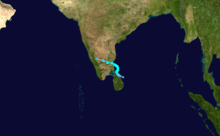Cyclone Nisha (2008)
| |||||
|---|---|---|---|---|---|
_26_November_2008_at_0525_UTC.jpg) Tropical Cyclone Nisha | |||||
| Formed | November 25, 2008 | ||||
| Dissipated | November 29, 2008 | ||||
| Highest winds |
3-minute sustained: 85 km/h (50 mph) 1-minute sustained: 100 km/h (65 mph) | ||||
| Lowest pressure | 996 mbar (hPa); 29.41 inHg | ||||
| Fatalities | 204 | ||||
| Damage | $800 million (2008 USD) | ||||
| Areas affected | Sri Lanka, India | ||||
| Part of the 2008 North Indian Ocean cyclone season | |||||
Cyclone Nisha (IMD designation: BOB 07, JTWC designation: 06B, also known as Cyclonic Storm Nisha) was the ninth tropical cyclone of the 2008 North Indian Ocean cyclone season, and the seventh tropical cyclone in the Bay of Bengal that year. A fairly weak tropical cyclone, it caused some notable damage in India and Sri Lanka.
Meteorological history

On November 24 an area of low pressure formed over land in Sri Lanka.[1] Later that day the Joint Typhoon Warning Center, assessed the area of low pressures chances of becoming a significant tropical cyclone within 24 hours as poor. This was due to the convection being minimal near the Low Level Circulation Center.[2] The next morning the JTWC issued a Tropical Cyclone Formation Alert on the area of low pressure predicting that it would have a good chance of becoming a significant tropical cyclone within 24 hours, as the Low Level Circulation Center was now moving into the Bay of Bengal.[3] Two hours later the IMD upgraded the area of low pressure to Depression BOB 07.[4] Three hours later the India Meteorological Department reported that the depression had intensified into a Deep Depression whilst remaining stationary.[5] Later that day the JTWC upgraded designated the Deep Depression as Tropical Cyclone 06B and reported that the depression had wind speeds equivalent to a tropical storm, on the Saffir Simpson Hurricane Scale.[6]
Early on November 26, the India Meteorological Department upgraded the deep depression to a Cyclonic Storm and named it Nisha. Later that day as Nisha moved northwest towards India, both the JTWC and the IMD reported that Nisha had reached its peak wind speeds of 55 kts (65 mph 100 km/h 1-min) 45 knots (50 mph 85 km/h 3-min).[7] Early the next day the IMD reported that Cyclonic Storm Nisha had made landfall in Tamil Nadu, India at 0030 UTC.[8] Later that day as the IMD reported that Nisha had weakened into a deep depression, The JTWC issued their final advisory on Nisha.[9][10] The IMD then reported that Nisha had weakened into a Depression and then issued their last advisory the next day as they had reported that Nisha had weakened into a well marked area of low pressure.[11][12]
Preparations and impact
| Death toll | ||
|---|---|---|
| Sri Lanka | 15 | [13] |
| Tamil Nadu, India | 189 | [14] |
| Total | 204 | |
Sri Lanka
Fifteen people were killed when Nisha hit northern Sri Lanka on November 25, 2008, causing heavy rains and flooding that reportedly displaced between 60,000 and 70,000 people in Vanni and 20,000 people in Jaffna district.[13] Jaffna recorded the highest rainfall since 1918, of 520.1 mm of rain in last week, with Wednesday’s reading of 389.8 mm, being the highest in nine decades.[15]
India
At least 189 people were killed by the heavy rains and floods caused by the Nisha in Tamil Nadu.[14][16] Some places have recorded extreme rainfall, notably Orathanadu, Thanjavur District where over 660 mm of rain fell within a period of 24 hours and broke the 65-year old record of highest rainfall registered in 24 hours in Tamil Nadu. In two days, Orathanadu registered 990 mm of rainfall. Previously the highest amount of rainfall in a day was 570 mm registered by Cuddalore on May 18, 1943.[17] In two days, Orathanadu registered 990 mm of rainfall. Overall in 4 days between 25 and 28th November, Orathanadu got 1280 mm making it as the 4th wettest Cylone in India. The most affected areas map released by ReliefWeb. Damage in India totaled to 3789 crores, or 800 million in 2008 USD.[18]
See also
2008 North Indian Ocean cyclone season
References
- ↑ "Tropical Weather Outlook 24-11-08 06z". India Meteorological Department. Retrieved 2008-11-27.
- ↑ "Tropical Weather Advisory 24-11-08 18z". Joint Typhoon Warning Center. Retrieved 2008-11-27.
- ↑ "Tropical Cyclone Formation Alert 25-11-08 07z". Joint Typhoon Warning Center. Retrieved 2008-11-27.
- ↑ "Special Tropical Weather Outlook 25-11-08 12z". India Meteorological Department. Retrieved 2008-11-27.
- ↑ "Special Tropical Weather Outlook 25-11-08 15z". India Meteorological Department. Retrieved 2008-11-27.
- ↑ "JTWC Warning 25-11-08 21z". Joint Typhoon Warning Center. Retrieved 2008-11-27.
- ↑ "JTWC Nisha Best Track". Joint Typhoon Warning Center. Retrieved 2008-11-28.
- ↑ "Special Tropical Weather Outlook 27-11-08 00z". India Meteorological Department. Retrieved 2008-11-28.
- ↑ "Special Tropical Weather Outlook 27-11-08 09z". India Meteorological Department. Retrieved 2008-11-28.
- ↑ "JTWC Warning 27-11-08 09z". Joint Typhoon Warning Center. Retrieved 2008-11-27.
- ↑ "Special Tropical Weather Outlook 27-11-08 15z". India Meteorological Department. Retrieved 2008-11-28.
- ↑ "Special Tropical Weather Outlook 28-11-08 03z". India Meteorological Department. Retrieved 2008-11-28.
- ↑ 13.0 13.1 http://www.reliefweb.int/rw/rwb.nsf/db900SID/EDIS-7LTQR4?OpenDocument
- ↑ 14.0 14.1 "Deep depression over Bay of Bengal weakens: Met Dept". The Hindu (Chennai, India). 2008-12-07.
- ↑ http://www.tamileelamnews.com/news/publish/tns_10537.shtml
- ↑ http://www.expressbuzz.com/edition/story.aspx?Title=CM+meets+Collectors&artid=sgQm60STlv4=&SectionID=vBlkz7JCFvA=&MainSectionID=fyV9T2jIa4A=&SectionName=EL7znOtxBM3qzgMyXZKtxw==&SEO=
- ↑ "Rain-related death toll rises to 51". The Hindu (Chennai, India). 2008-11-28.
- ↑ http://reliefweb.int/rw/fullMaps_Sa.nsf/luFullMap/3A95CE6C7BB78225C125750F0055CEEB/$File/rwmm_TC_asi081128.gif?OpenElement
External links
| Wikimedia Commons has media related to Cyclone Nisha (2008). |
| |||||||||||
